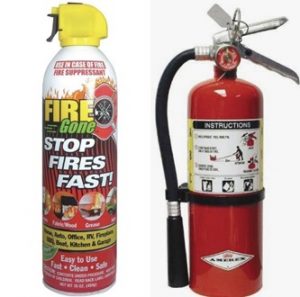
As spring draws near and we look forward to the end of winter weather, many of us will begin to stock up our recreational vehicles in preparation for warm-weather travel. While you’re doing so some RV spring cleaning and gathering supplies, here are 5 essential items that we recommend keeping in your RV.
1) Trauma Kit. This one will cost at least $50 if you purchase a complete, ready-to-go kit. However, you can buy the items individually and assemble a kit for under $50, or close to it. Many people keep first aid kits in their RVs and homes. However, most first aid kits contain items to remove a splinter, clean a skinned knee, or apply ointment to a minor burn. The typical first aid kit that most people have in their RV is not equipped with lifesaving equipment. One of the most essential items of any trauma kit is a tourniquet. Quick application of a tourniquet in the case of an injury resulting in a major bleed is critical. Many studies have shown that quickly applying a tourniquet greatly increases the chances of survival. One downside to tourniquets is that they can only be used on limbs (arms and legs). Bandages with a clotting agent are important to have to stop wounds that are not on the limbs from bleeding. Chest seals and are other items that are important to have in a trauma kit. Of course, having these items does no good if you are not knowledgeable of how to use them. Taking the time to invest in training on how to use these items is also important. Once equipped with the right lifesaving equipment and the knowledge of how to use it, you will be able to enjoy your travels knowing that if an emergency does occur, you have the tools and information needed to act and keep yourself and your loved ones safe.

2) Fire Extinguisher. Many RVs already have fire extinguishers; however, oftentimes we forget to check the expiration date. Having working fire extinguishers on board definitely is essential. If you already have fire extinguishers, be sure to keep track of when they expire, so that you can get a replacement. Fire extinguishers vary in size, and it is possible to purchase smaller, compact fire extinguishers that are very effective and take up less room. Investing in fire extinguishers could one day prevent your entire RV from going up in smoke. If you tow a vehicle on your trips, having a small, compact fire extinguisher in that vehicle is also a good idea.

3) Flashlight. Having a flashlight in your RV seems like a no-brainer, and the overwhelming majority of RV owners do keep a flashlight on hand. So, why mention it? Because quality matters, and a good flashlight is more than just a tool to help you see at night. We recommend an LED flashlight that is at least 120 lumens. In addition, we suggest a flashlight that is rechargeable, includes a retention clip, and has a run time of at least two hours. While a flashlight’s main purpose is to help you see at night, there are many other important uses for this tool. Flashlights can be used for self-defense. In a dark environment, shining the bright light into the eyes of an attacker will momentarily blind and disorient them and can give you a chance to get away. Flashlights are also a useful way to get people’s attention and signal for help if you are injured or lost in an isolated area.

4) Seatbelt Cutter/Glass Breaker. It is inevitable that there will be traffic accidents on the roadways. Having a tool that is both a glass breaker and a seatbelt cutter can assist you in freeing yourself and loved ones if you become trapped in your RV or vehicle while traveling. In addition, as you travel, there is also a real possibility that you may encounter a traffic accident before emergency services have arrived. Having this tool could allow you to assist people involved in the accident. Many of these tools are very compact, and there are versions so small that they can act as a key ring.
5) Pepper Spray. Pepper spray is a great self-defense item, and we highly recommend having it with you as you travel. It is highly effective and does not require a great amount of size or strength to use successfully. Pepper spray can be used to defend against human attackers as well as dogs or wild animals. Pepper spray containers range from small keychain size to 16-ounce units. The distance and amount of the spray will vary depending on the size of the canister and how it is dispersed. As a general rule, we recommend spray that has a range of at least 10-12 feet. Also, pepper spray can be dispersed as a cone, stream, gel, or foam. Stream, gel, and foam generally will travel farther than the cone, but since the former versions spray in a line, there is a chance of missing your target. Cone disbursement requires less accuracy, because it covers a larger target area with its cone-shaped pattern. However, if one is using the spray indoors, the cone disbursement can get into the ventilation system and be distributed throughout the building or RV.
These and other safety products will help to ensure that you and your loved ones are prepared should an emergency happen while you are traveling. However, no amount of products can guarantee that a crisis situation will not occur. Purchasing products like the ones listed above should be part of an overall mindset to be prepared should an emergency occur. Developing a plan and talking it over with your travel companions should be part of that as well.
So, get out and enjoy seeing new places and making new memories in your RV. Having a little bit of knowledge, an emergency plan, and the right products will give you the confidence of knowing that should an emergency arise, you have prepared yourself to handle it.
|
John Hill and John Heise are active career law enforcement officers with over 30 years of experience. They also own Shield Protection Products which provides self defense and safety products. In their free time they enjoy spending time with family and traveling. For additional information or questions you can visit their website: www.shieldprotectionproducts.com |


Great advice all around, and as an AEMT, glad to see the advice on a tourniquet…I don’t even hike without one in my pack.